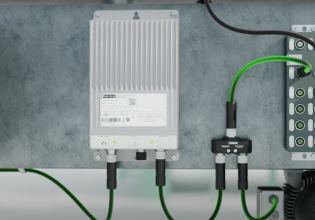SICK Addresses Challenging Object Detection in Manufacturing Facilities with Latest Sensors
SICK introduced the new W4F miniature photoelectric sensor, designed for challenging object detection tasks in tight installation spaces.
SICK’s optoelectric sensors are now available in a miniature size. With the company’s new application-specific integrated circuit (ASIC) technology platform, W4F sensors allow versatile applications in a wide range of challenging installation situations.
Smart Sensors for Industry 4.0
The W4F product family uses technologies including double line, V-optics, foreground suppression, and multi-switch. These technologies aim to improve the background suppression and detection performance for flat, transparent, and highly reflective objects.
Video used courtesy of SICK AG
Two switching points and distance value output in one device allow expanding the application possibilities. These smart sensors are integrated with BluePilot operating interface and highly visible light spot. With the latest diagnostic and monitoring functions, they are designed for future use in Industry 4.0 facilities.
Implementing the BluePilot and ASIC Platform
SICK’s new miniature photoelectric sensors implemented the Blue Pilot operating concept. The blue LED display as the alignment aid gives users direct feedback to accelerate the process and improve operational safety.
When detecting contamination or vibration, the Blue Pilot also can help correct faults early on and prevent unplanned system downtime. The platform can do this by providing a visual indication for detection quality drop. The sensors can be adjusted with a push-turn mechanism and potentiometer,
The development of the new ASIC platform allows the diffuse LED and the two light-intensive pin-point emitter LEDs to operate concurrently without temperature-related failure. The platform also helps increase sensitivity, sensing range, and detection reliability for poorly reflecting object surfaces by directly digitalizing the photocurrent of the reflected light. In addition, the digital filters of the ASIC offer “one of the best” ambient light suppression on the market.
Sensor Solution for Two Business Field
According to SICK, the W4F comprises both the optical standard and optical expert's sensor business fields. Compared with the preceding product family, it increases up to 47% working distance and reduces 38% black/white shift between the object and the background.
With the help of the laser-like light spot and V-optics, the W4F can detect flat, transparent, or reflective objects such as glass panes, wafers, or displays.

The new W4 sensor from SICK. Image used courtesy of SICK AG
The two line-shaped line spots (double line) can detect uneven surfaces with recesses, holes, or drillings, including printed circuit boards with cut-outs.
Multiswitch functionality helps to distinguish the lying and standing objects. Using distance value output via IO-Link, W4F with two switching points can be used to monitor assembly processes, the diameter of film, packaging materials, label rolls, and check high and low fill levels for food packaging applications.
The technology of foreground suppression allows the sensors to detect highly reflective and flat objects such as cookies, chocolate bars, or assemblies.
IO-Link Users Access
The IO-Link access can help monitor the detection in real-time, including a “current receiver level” read-out. The smart features for sensor monitoring and diagnosis functions, along with IO-Link, enables W4F to work for digitized machines and applications.
The diagnostic functions are designed to monitor sensor status. When the degree of temperature or contamination beyond pre-set limits, the sensors can automatically initiate maintenance and identify the cause of failure using diagnostic data.





